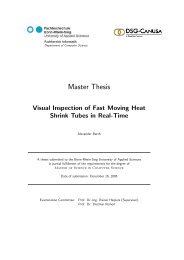Master Thesis - Hochschule Bonn-Rhein-Sieg
Master Thesis - Hochschule Bonn-Rhein-Sieg
Master Thesis - Hochschule Bonn-Rhein-Sieg
You also want an ePaper? Increase the reach of your titles
YUMPU automatically turns print PDFs into web optimized ePapers that Google loves.
2. Overview on human-robot <strong>Master</strong> <strong>Thesis</strong> Björn Ostermann page 11 of 126<br />
2.2 State of science – Related Work<br />
The first approaches on safe interactions of humans and industrial robots were made in the 80s. After<br />
the first death of a worker related to a robot accident, reported in 1982 [1], safety studies in 1983<br />
concluded that a robot could only be safe if the robot could detect the approach of a human and react<br />
accordingly [2].<br />
In 1985 [3] Graham and Meagher of the Rensselaer Polytechnic Institute in New York investigated<br />
microwave, ultrasound, infra-red and capacitive sensors on their applicability in collaborative<br />
workplaces. They continued their work, together with Derby, in 1986 [4] resulting in the conclusion<br />
that “much research still needs to be done on robotics safety”. The Rensselaer Polytechnic Institute is<br />
still working in the field of safe robot-human collaboration. In one of their latest projects from 2007<br />
[5] Meisner, Isler and Trinkle used a galvanic skin response sensor, measuring the workers stress<br />
level, to generate robot trajectories.<br />
In 1989 [6] Takakura et al. outfitted a robot with torque sensors and programmed an algorithm that<br />
worked on contact sensing and memorization of objects. Although this approach was not feasible in<br />
praxis, due to the reduced speed of the robot, in order to avoid any damage by collisions, and problems<br />
with dynamic objects, whose changed positions can not be tracked, the idea of using torque sensors<br />
persists until today (see chapter 2.2.2).<br />
In 1992 and 1994 Novak and Feddema used capacity sensors for object avoidance [7]. The advantage<br />
of this approach is that the robot does not need to touch the obstacle, but can sense it in its vicinity.<br />
While increasing the sensor range from touch to close vicinity was an improvement, the problem in<br />
this approach is the different reactions of capacity sensors to different materials.<br />
Ebert and Henrich presented in 2002 a solution that used a multiple camera system to detect collisions<br />
between the robot and obstacles [10]. The problems they reported for this approach existed in cells<br />
being reported as occupied while free and vice versa and in the robot blocking the view of the cameras<br />
in certain positions. In later projects by Henrich this problem has been reduced but not completely<br />
solved (see chapter 2.2.3).<br />
Heiligensetzer and Wörn demonstrated in 2002 [20] [21] a Kuka Robot, equipped with capacity<br />
proximity sensors and haptic devices. Heiligensetzer continued the approach, using capacitive<br />
proximity and tactile sensors, in 2004 [19] and 2007 [57]. A problem in approaches using force<br />
sensors is always the reduced speed of the robot, which is necessary to avoid harm to humans. The<br />
robot presented in 2007 was therefore also equipped with collision absorbing material, making it<br />
possible to detect a collision before harm is done to the worker. Wörn continued his work in this field<br />
in 2004 [22], together with Yigit and Burgart, by developing a reflex based control for industrial<br />
robots, in which reflexes take over the control if a dangerous situation is detected.














